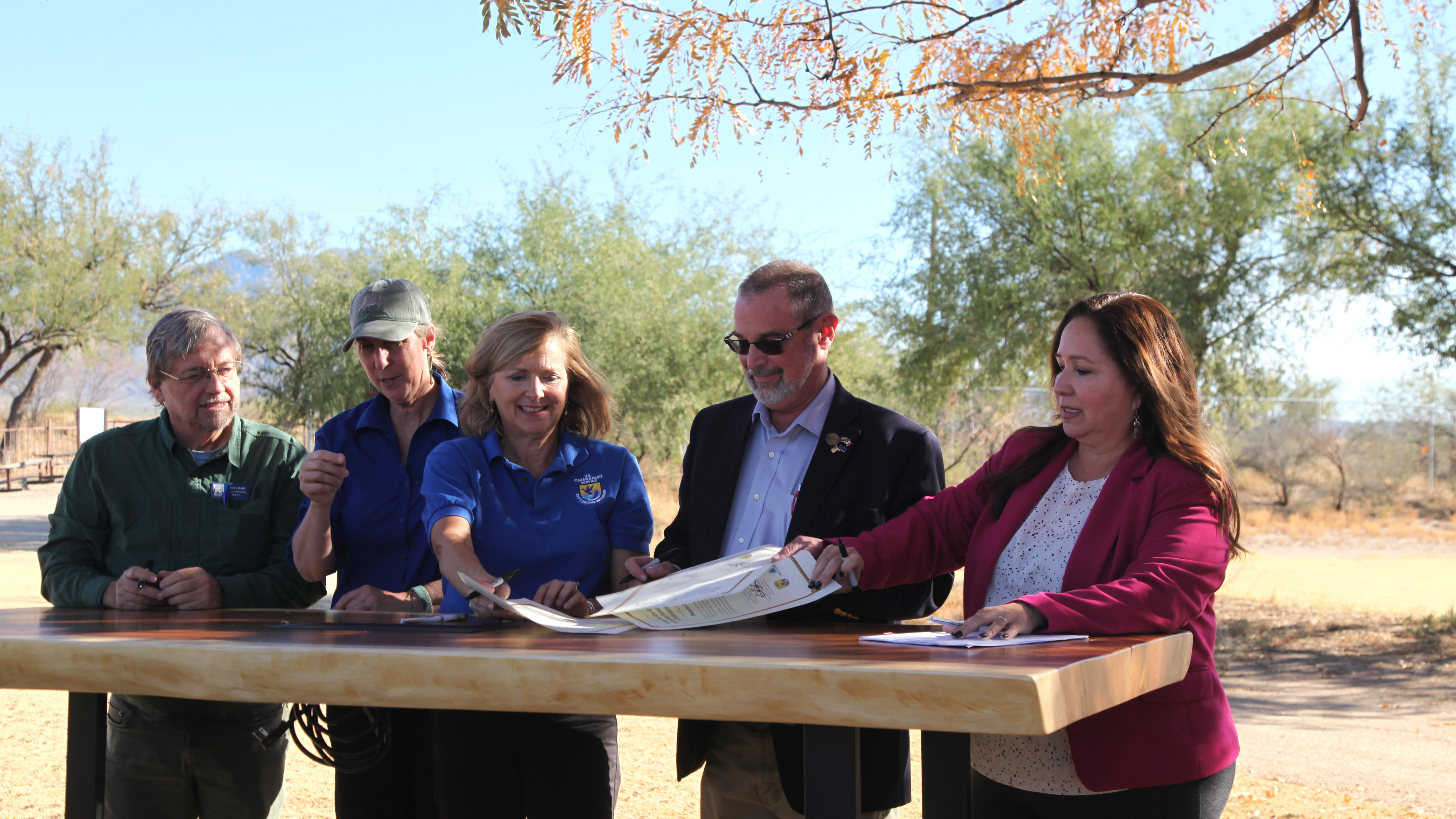 Officials from local and federal agencies sign the Santa Cruz River Wildlife Partnership Memo of Understanding at the Historic Canoa Ranch in Green Valley, Ariz., on Thursday, Nov. 21, 2024. From left to right: Kevin Dahl, City of Tucson council member for Ward 3, Martha Williams, Director for the U.S. Fish and Wildlife Service, Amy Lueders, Southwest Regional Director for the USFWS, Bruce Bracker, Santa Cruz County Vice-Chair and Supervisor for District 3 and Adelita Grijalva, Pima County Chair and Supervisor for District 5.
Officials from local and federal agencies sign the Santa Cruz River Wildlife Partnership Memo of Understanding at the Historic Canoa Ranch in Green Valley, Ariz., on Thursday, Nov. 21, 2024. From left to right: Kevin Dahl, City of Tucson council member for Ward 3, Martha Williams, Director for the U.S. Fish and Wildlife Service, Amy Lueders, Southwest Regional Director for the USFWS, Bruce Bracker, Santa Cruz County Vice-Chair and Supervisor for District 3 and Adelita Grijalva, Pima County Chair and Supervisor for District 5.
On Thursday, officials from local and federal agencies gathered at the Historic Canoa Ranch in Green Valley to sign a Memo of Understanding (MOU) establishing the Santa Cruz River National Urban Wildlife Refuge Partnership.
This collaboration marks the first of its kind in Arizona that could lead to the creation of the state’s first urban national wildlife refuge.
The partnership brings together representatives from the City of Tucson, Pima County, Santa Cruz County and the U.S. Fish and Wildlife Service (USFWS) who will work together to promote community-led environmental stewardship and protect the wildlife corridor stretching from the Mexican border through Pinal County.
Beyond conservation efforts, the partnership could also attract future federal funding for river restoration and protection.
“What [we] don’t want to do is take resources from other refuges to create this one and so it would really be a lobby for an increase in funding and not only by the different counties and cities that are going to be involved but federal investment,” said Adelita Grijalva, Chairwoman of the Pima County Board of Supervisors.
However, changes in presidential administrations could complicate efforts to secure federal support.
Martha Williams, director of the USFWS expressed optimism and emphasizing that the agency remains committed to community-driven conservation.
“I don’t expect support for that to change, what the actual money looks like is hard to know, hard to predict the unpredictable but I see the Fish and Wildlife Service very much being part of this conversation into the future,” Williams said.
Williams, who was appointed by President Joe Biden in October 2021, will step down as director in January.
Amanda McAdams, regional chief of refuges for the USFWS southwest region underscored conservation efforts as a long-lasting issue.
“It’s not about an election or how we got here, whether it’s hunting and fishing, whether it’s taking care of endangered or threatened species, whether it’s talking about migratory birds, that’s something that most Americans believe in and we’re just really happy to help accelerate the impact of that,” McAdams said.
Williams also described the partnership as a model for future conservation efforts.
“The Fish and Wildlife Service has been trying to build more urban refuges but also really building the concept of community-led wildlife conservation,” Williams said.
The proposed refuge aims to conserve natural resources along the Santa Cruz River and establish a permanent wildlife habitat and increasing outdoor access for the public.
Grijalva highlighted opportunities for additional partnerships, including potential collaborations with the Pascua Yaqui and Tohono O’odham tribal nations as well as bordering cities.
“It means not just protecting the environment and putting a big gate around it but it’s inviting the community and the world to come and look at what is possible when you look at preservation [as] a way for welcoming people back into what used to be,” Grijalva said.
Amy Lueders, southwest regional director for the USFWS called the partnership a durable effort.
“It’s an important first step where the power of working together amplifies everybody’s efforts and to see how passionate people are here are and throughout this process have been about this place,” Lueders said.
In September, the USFWS approved two landscape conservation designs in collaboration with the Santa Cruz River Refuge Coalition, outlining a blueprint to protect regional habitats and species.
The agency also hosted two community-planning events to gather input.
Looking ahead, McAdams said the partnership will expand its stakeholder group and continue to plan future engagement events.
“Our goal is to increase the conservation impact to amplify that as much as we can and we can’t do that without those local voices so it’s really trying to find a way to get everyone to the table so we can have that genuine local support and local voice for what conservation should look like here,” McAdams said.

By submitting your comments, you hereby give AZPM the right to post your comments and potentially use them in any other form of media operated by this institution.